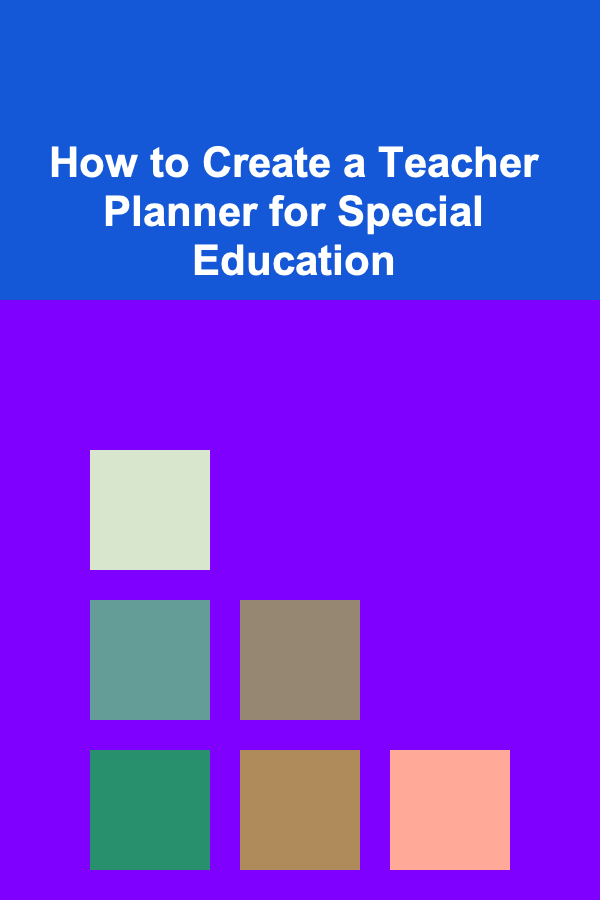
How to Create a Teacher Planner for Special Education
ebook include PDF & Audio bundle (Micro Guide)
$12.99$7.99
Limited Time Offer! Order within the next:

Creating a teacher planner for special education is a crucial tool that helps educators stay organized, track student progress, and manage their classrooms effectively. A well-designed planner allows special education teachers to meet the diverse needs of their students, implement individualized education plans (IEPs), and ensure that they are adhering to both legal requirements and best practices. In this article, we will explore the key elements of an effective special education teacher planner, how to organize it, and how to tailor it to the unique demands of the special education classroom.
Understanding the Role of a Special Education Teacher Planner
Special education teachers work with students who have a range of disabilities, including learning disabilities, developmental disorders, emotional disturbances, and physical disabilities. These students often require individualized instructional plans and accommodations to ensure they can succeed in the classroom. A teacher planner for special education should support this by providing structure, tracking, and flexibility to meet the unique needs of every student.
Key functions of a special education teacher planner include:
- Tracking student progress: Monitoring the development of each student's skills, behaviors, and goals.
- Managing IEPs: Organizing and maintaining detailed records related to each student's Individualized Education Plan (IEP).
- Scheduling meetings: Coordinating meetings with parents, special education staff, and other professionals involved in student care.
- Lesson planning: Developing tailored lessons that align with both academic and social goals.
- Behavioral tracking: Keeping track of behavioral interventions and progress.
Essential Components of a Special Education Teacher Planner
Creating an effective planner begins with understanding the critical components that need to be incorporated. Below are the key sections to include in a special education teacher planner.
A. Student Profiles
One of the most important features of a special education planner is the section dedicated to student profiles. Each student should have their own profile page that includes:
- Personal Information: Name, grade level, school year, and emergency contact information.
- Disabilities: A brief description of the student's disability and how it affects their learning.
- IEP Goals: Specific, measurable goals outlined in the student's IEP.
- Accommodations and Modifications: A list of the accommodations and modifications the student requires (e.g., extra time on tests, alternate formats for assignments).
- Behavioral Needs: Any specific behavioral interventions and goals.
- Support Services: The services the student receives, such as speech therapy, occupational therapy, or counseling.
B. IEP Goals and Objectives
This section should provide space for teachers to record the student's short-term objectives and long-term goals. IEP goals are typically updated annually, but it's important to break them down into smaller objectives for tracking progress.
For each student, you should have:
- Annual Goals: Clearly defined objectives that the student should achieve by the end of the year.
- Short-Term Objectives: Measurable benchmarks that show progress toward the annual goal.
- Progress Monitoring: A system for checking how well students are meeting their goals, whether through assessments, observations, or other tools.
C. Lesson Planning and Modifications
Lesson planning is another critical part of a special education teacher's responsibilities. A special education teacher planner should offer a section for lesson plans that includes:
- Weekly or Daily Plans: Space to plan lessons for specific subjects or skills. Plans should include specific accommodations for each student's needs.
- Modification Section: For each lesson, provide a section to outline how the lesson will be modified or differentiated based on individual student needs.
- Special Instructional Strategies: Document specific teaching strategies that work for students with particular learning challenges (e.g., visual aids, hands-on activities, or assistive technology).
Structuring Your Teacher Planner
The structure of the planner should be intuitive and user-friendly, helping the teacher stay organized without feeling overwhelmed. Below are some suggestions for how to structure the planner effectively.
A. Monthly Overview
A monthly calendar page can be very useful for organizing key events such as:
- IEP Meetings: Record dates and times for meetings with parents, case managers, and other specialists.
- School Holidays: Mark out breaks and holidays to adjust lesson plans accordingly.
- Special Events: Record important school-wide events, such as field trips or assessments.
B. Weekly Schedule and Student Focus
Each week should have a designated section where teachers can outline:
- Classroom Schedule: Include blocks for different subject areas or activities, like math, reading, physical therapy, and one-on-one sessions.
- Focus Students: Identify specific students who may need extra attention or modifications for the week. This allows the teacher to monitor progress or address any issues in a timely manner.
C. Daily Planning Pages
Daily planning pages are essential for breaking down lesson goals, accommodations, and student needs on a more granular level. These pages should allow the teacher to:
- Plan for the Day: Outline each activity, lesson, or session.
- Student-Specific Modifications: For each lesson, note the individual accommodations and strategies used to support students with disabilities.
- Behavioral Strategies: If behavioral support is needed, document the plan for managing behavior throughout the day.
- Progress Notes: At the end of the day, leave space for reflections on what went well, any issues that arose, and follow-up plans for the next day.
Tools for Tracking Student Progress
Beyond lesson planning, a special education teacher planner should have systems in place to track student progress on their IEP goals and objectives. This allows teachers to monitor how well students are performing and make any necessary adjustments to their teaching strategies.
A. Progress Monitoring Charts
Use charts or graphs to visually track the progress of students toward their IEP goals. These could include:
- Behavioral Progress: Track changes in behavior using a chart or scale.
- Academic Achievement: Record student progress on academic benchmarks.
- Skill Development: Track the development of specific skills, such as fine motor skills or social-emotional learning.
B. Student Journals or Checklists
Another useful tool is a student journal or checklist. These can be used to record feedback on a daily or weekly basis and serve as a way to reflect on each student's development.
C. Assessment Data and Reflection
Incorporate space for collecting assessment data, whether informal or formal. This allows teachers to have a record of student performance on tests, quizzes, or informal assessments. After each assessment, leave space for reflection on whether students need additional support or if new strategies need to be implemented.
Personalizing the Planner to Fit Your Needs
Special education teachers have unique needs that require adaptability and flexibility in their planning. The beauty of a teacher planner is that it can be personalized to best fit your teaching style, classroom management approach, and the specific needs of your students.
A. Design Customization
You can customize the layout of the planner to ensure it aligns with your goals. Some teachers prefer a digital planner, while others prefer a physical one. Regardless, consider adding:
- Color Coding: Use colors to differentiate between students, IEP goals, and types of modifications.
- Tabs or Dividers: These can help quickly navigate between different sections (e.g., student profiles, lesson plans, assessments).
- Checklist Pages: A checklist can help ensure you stay on top of the numerous tasks and responsibilities special education teachers have.
B. Incorporate Reflection and Self-Care
Self-care is an essential component for maintaining mental and emotional well-being. Include space for reflection where you can jot down personal thoughts, areas for improvement, or successes. You could also add reminders for self-care practices, like taking breaks, seeking support, or practicing stress-reduction techniques.
Tools and Resources to Complement the Planner
While the teacher planner is a central tool, there are additional resources that can support special education teachers in creating a well-rounded plan for their students.
A. Assistive Technology Tools
Incorporating assistive technology can provide valuable support for students with disabilities. Familiarize yourself with resources like:
- Text-to-Speech Programs: These help students who struggle with reading or dyslexia.
- Speech-to-Text Software: These tools support students who have difficulty writing.
- Interactive Learning Apps: These apps can support visual, auditory, or kinesthetic learners.
B. Collaboration with Other Educators
Special education teachers often work closely with other educators, such as paraprofessionals, speech-language pathologists, and occupational therapists. Collaboration is key to success, and the teacher planner can serve as a tool for documenting and sharing important information with other team members.
Conclusion
A teacher planner for special education is an indispensable tool for staying organized, managing IEPs, and ensuring that each student receives the support they need. By incorporating sections for student profiles, lesson plans, progress tracking, and accommodations, teachers can ensure that their students are making meaningful progress toward their goals. Personalizing your planner and regularly reflecting on the effectiveness of your strategies will help you continue to meet the diverse needs of students in your care. Special education is a challenging but rewarding field, and with the right planning tools, educators can make a significant difference in the lives of their students.
Reading More From Our Other Websites
- [Home Staging 101] How to Stage a Bathroom for a Luxury Feel
- [Tiny Home Living Tip 101] How to Create a Pet‑Friendly Tiny Home Without Sacrificing Space
- [Home Renovating 101] How to Plan a Home Renovation for Maximum Flow and Functionality
- [Organization Tip 101] How to Create a Summer Camp Packing List for Kids
- [Home Security 101] How to Protect Yourself from Identity Theft with Smart Security Practices
- [Home Pet Care 101] How to Train Your Dog to Walk on a Leash Without Pulling
- [Home Renovating 101] How to Update Your Home's Insulation During Renovation
- [Organization Tip 101] How to Collaborate with Neighbors for a Block Yard Sale
- [Home Family Activity 101] How to Master Water Balloon Games for the Backyard: Splashing Fun and Safety Tips
- [Ziplining Tip 101] How to Plan a Multi‑Day Zipline Expedition Across Southeast Asia

Effective Strategies for Selling Digital Marketing E-books
Read More
How to Budget for Home Appliances and Technology Upgrades
Read More
Promoting Good Sportsmanship: A Comprehensive Guide
Read More10 Tips for Tracking Supply Chain Disruptions and Their Market Impact
Read More
10 Tips for Optimizing Your Marketing Planner for ROI
Read More
10 Tips for Improving Volleyball Serve Receive
Read MoreOther Products

Effective Strategies for Selling Digital Marketing E-books
Read More
How to Budget for Home Appliances and Technology Upgrades
Read More
Promoting Good Sportsmanship: A Comprehensive Guide
Read More10 Tips for Tracking Supply Chain Disruptions and Their Market Impact
Read More
10 Tips for Optimizing Your Marketing Planner for ROI
Read More